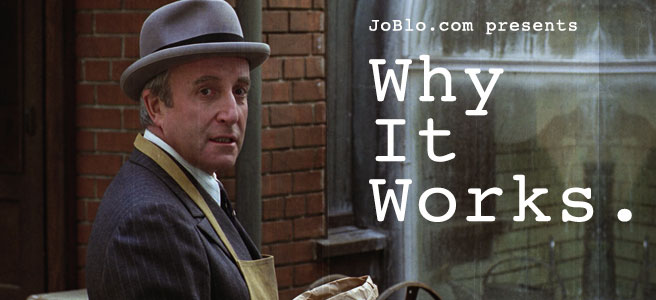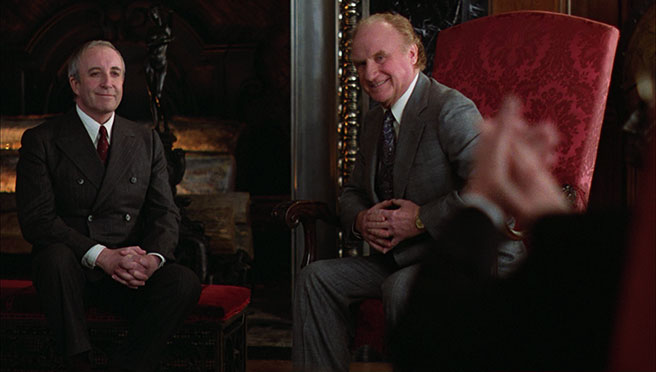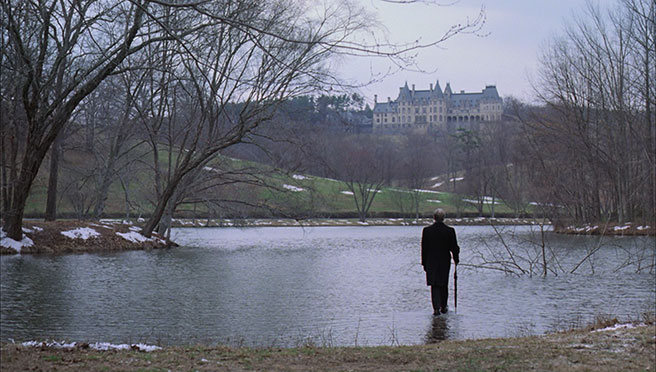Last Updated on July 31, 2021
 Why It Works is an ongoing column which breaks down some of the most acclaimed films in history and explores what makes them so iconic, groundbreaking, and memorable.
Why It Works is an ongoing column which breaks down some of the most acclaimed films in history and explores what makes them so iconic, groundbreaking, and memorable.
****SPOILERS AHEAD****
In my time analyzing movies, one film that has always stood out to me is Hal Ashby's BEING THERE. Not only is it memorable and timeless, but it breaks the rules of screenwriting in a big, bad way. As demonstrated by films like KRAMER VS. KRAMER, ALIEN, and THE SHINING the late 1970's and early 1980's blended the naturalistic filmmaking of the 70's with the 80's push for a more entertaining movie, and BEING THERE is no exception. With a dim-witted lead character (masterfully played by Peter Sellers), a zany, somewhat directionless plot, and a baffling ending, BEING THERE is a stunning piece of modern cinema. Here's why it works:
WHY WE LIKE THE CHARACTERS:
There's a fairly standard rule in screenwriting that says the main character absolutely must be the one who drives the plot forward- a rule which BEING THERE ignores with a fury. In some ways, it's the deliberate refusal to follow this rule that makes the story so compelling. Instead of a cool hero or a flawed but noble protagonist, we basically have a blank slate upon which the audience and the other characters can project whatever they want to see. That isn't enough to carry a film though, and so we also have in Chance a childlike, television-obsessed innocence juxtaposed with fine suits, polite behavior, and an overall distinguished look. These dynamics go a long way to us believing the other characters can see him as an eccentric instead of an idiot… because let's be clear, he is absolutely an idiot. In Eve and Benjamin Rand, we have a different kind of innocence, with the pair wanting someone to look after Eve and carry on Ben's legacy and both hoping "Chauncey Gardiner" is just the man for the job. Finally, we have the President of the United States, who while less enthralled with Chance than the others, is still fooled by their short meeting, at least enough to set forth the ensuing political antics and lose his libido in the process.
 "As long as the roots are not severed, all is well, and all will be well in the garden."
"As long as the roots are not severed, all is well, and all will be well in the garden."
WHY WE CARE:
As mentioned above, a big part of the fun of the story is seeing just how far the filmmakers can take Chance's accidental ruse. Instead of Chance being some con man trying to wheedle his way into the political fabric, he's just a middle-aged boy whose love of gardening is mistaken for philosophy. Politics can be dull in films, though, so at the forefront of the story we also have Eve's growing affection for Chance. She knows she's losing her husband, and like we've all done at one point or another, she lets herself believe Chance is everything she's ever wanted, letting everything he says and does mean exactly what she wants it to. Meanwhile, as Chauncey Gardiner's political presence flourishes, a few of the minor characters begin to suspect he's not all he's cracked up to be. While BEING THERE doesn't really have any bad guys or major obstacles, this bit of suspicion adds a nice undercurrent of tension to the plot and enhances the verisimilitude of a pretty ridiculous story.
 "You set me free, Chauncey… and I reveal myself to myself, and I am drenched and purged."
"You set me free, Chauncey… and I reveal myself to myself, and I am drenched and purged."
WHY WE'RE SATISFIED:
As Benjamin Rand finally succumbs to his illness, the President gives a thoughtful speech while the politician pallbearers discuss candidates to take on the presidency in the new term, eventually agreeing on Chauncey Gardiner as the clear choice. Meanwhile, Chance has wandered off, because of course he has. This much in itself is a fitting end to the story- that Chance could blunder upward all the way to the presidency- but what happens next adds another layer to the story entirely. After straightening a fallen sapling, Chance walks onto the surface of a lake, taking several steps before realizing there's a body of water beneath his feet. Now, this ending was not in the book or the original script and was rather added by Hal Ashby almost on a whim, so it's up to you how much to read into it, but it certainly falls in line with the theme of the film and leaves you thinking long after the credits roll, as I'll get into in the next section.
 This scene feels like it's straight out of a Magritte painting.
This scene feels like it's straight out of a Magritte painting.
WHY WE REMEMBER:
There are several philosophical angles that can be discussed with BEING THERE. Chance's knowledge of the world solely from television is a direct descendant of Plato's cave allegory, his political rise is a clear satire of government, Eve's growing affection for Chance is an entertaining look at how we can fool ourselves into a relationship, and the final shot of the film adds the potential for religious discussion into the mix. Simply put, BEING THERE is a story about ignorance and our tendency to see what we want to see rather than taking the extra steps to look deeper- whether it be in politics, religion, relationships, or any other belief (it's fitting that Monty Python's LIFE OF BRIAN was released in the same year). All of this is cleverly embedded in a hilarious script by Jerzy Kosiński, who also wrote the original novel (in which Chance's accidental flirtation with a male party guest actually progresses all the way to, um, completion). Hal Ashby delivers his trademark directing, which feels at once emotional, natural, and still relevant over thirty-five years later. Finally, Peter Sellers gives one of the most outstanding performances of his career, with Shirley MacLaine, Melvyn Douglas, and Jack Warden each giving their own powerhouse perfomance in turn. I'd love to hear your interpretations of the story, but in the meantime, I'll leave you with the Presidents final words, quoting Benjamin Rand as Chance the gardener strolls atop a still lake: "life… is a state of mind."
Thoughts? What else worked for you? What didn't? Strike back below!
If you have any movies you'd like to see put under the microscope, let us know below or send me an email at [email protected].
















Follow the JOBLO MOVIE NETWORK
Follow us on YOUTUBE
Follow ARROW IN THE HEAD
Follow AITH on YOUTUBE